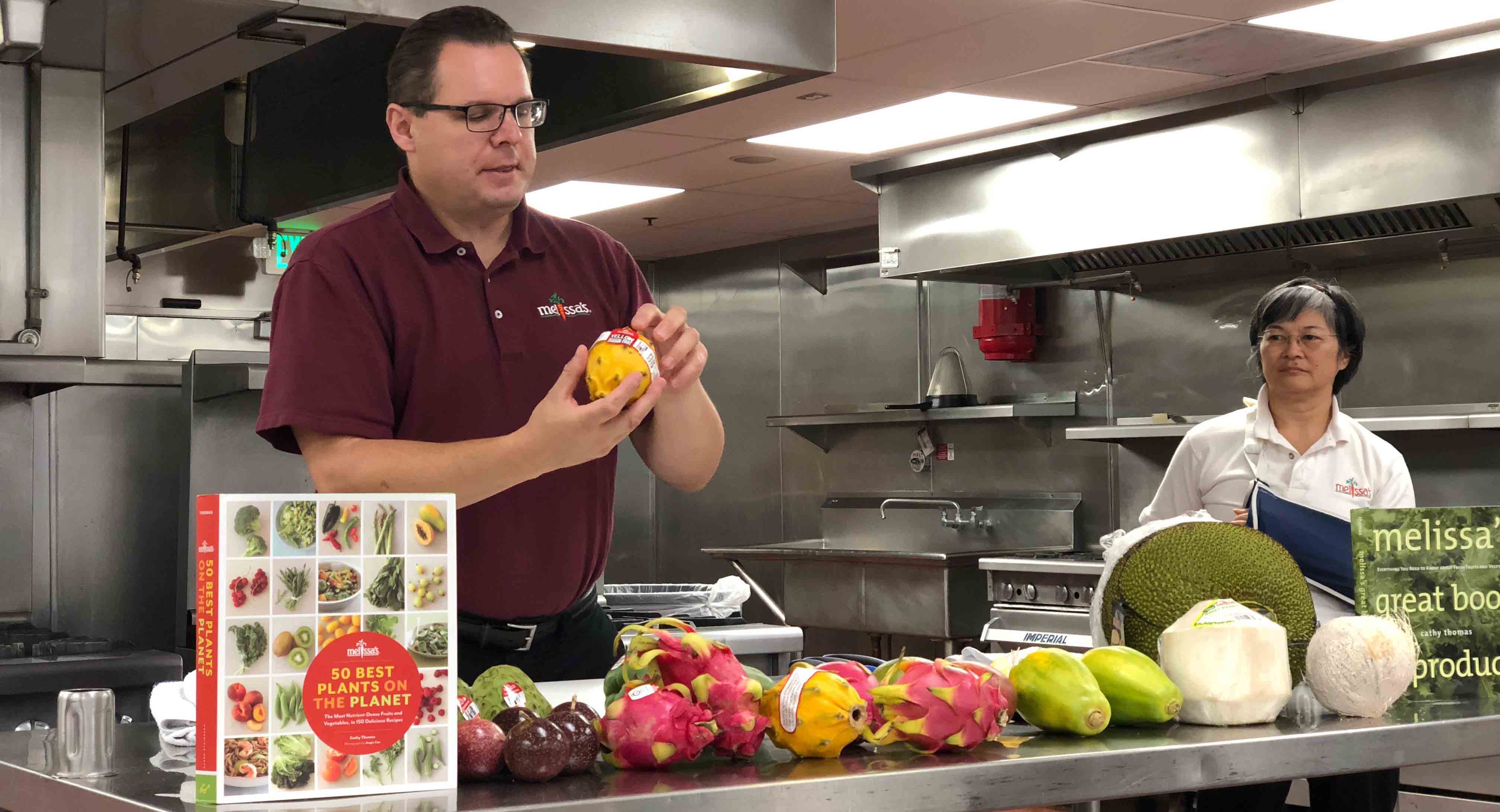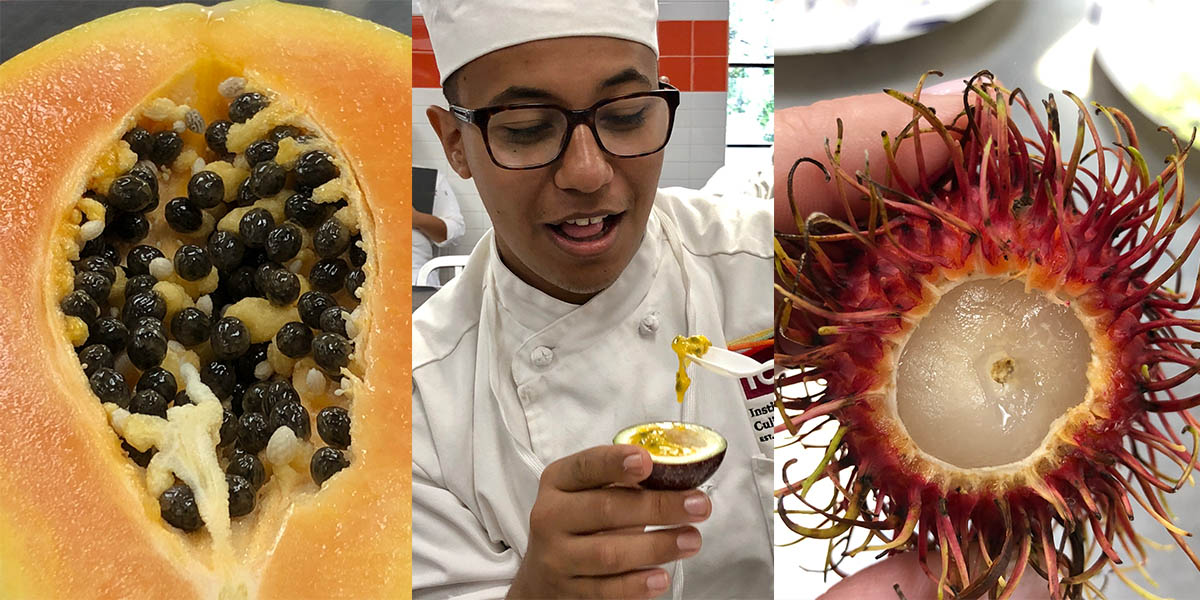
Get to Know Exotic Fruits
Melissa’s Produce Director of Public Relations Robert Schueller shares tips and fun facts about six trendy fruits.
Could you confidently identify a cherimoya? Or know precisely when a dragon fruit has reached peak ripeness? We weren’t convinced about our tropical fruit knowledge either, until Robert Schueller, director of public relations at Los Angeles-based Melissa’s Produce, the largest distributor of specialty produce in the United States, came to the Institute of Culinary Education’s Los Angeles campus to educate students on this natural food trend.

Tropical fruits are having a moment, working their way into cocktails (NoMad), pastries (Proof Bakery and Dominique Ansel Bakery) and even vegan tacos (Trejo’s Tacos). According to Schueller, it’s in part due to the diversity, beauty and visual impact that these fruits offer. He says the biggest produce trends in this category are dragon fruit, jackfruit, papayas, mangoes, passion fruit and cherimoya. “Dragon fruit are different than your typical fruit flavor profile,” says Schueller. “The plate presentation is what’s making them so popular now with bi-color flesh of white and magenta, three varieties of the fruit and flavors running from mild to super-sweet.”
If you’re curious how to safely cut into a jackfruit or when to crack into a passion fruit, here are a few of the things students learned from Robert Schueller’s visit.
Jackfruit
- Availability: Year-round as it flourishes in Mexico and Southeast Asia.
- Flavor/Aroma: Generally sweet — some say it resembles the flavor profile of Juicy Fruit gum.
- Test for Ripeness: Fruit must be fragrant and the skin will change from green to yellow-brown when ripe.
- Tips: Wearing gloves, use a chef's knife sprayed with vegetable oil to prevent stickiness and difficulty in cutting. If you want to eat the seeds, cook them.
- Fun Fact: The jackfruit is the go-to vegan substitute for pulled pork and is often the key ingredient in meatless tacos and sliders. From the outside, the fruit is often mistaken for Durian — which has a strong (read: foul) aroma.
Dragon Fruit
- Availability: Domestic dragon fruit is available from August through December; imported dragon fruit is available year-round.
- Flavor/Aroma: Sweet with mild somewhat melon-like aroma and flavor with acidic notes and a texture similar to that of kiwi.
- Test for Ripeness: Usually sold ripe and ready to enjoy.
- Tips: Cut off the ends with a knife and peel off the skin.
- Fun Fact: Melissa’s introduced the dragon fruit, which is also known as the “fruit of the cactus,” to the American market 17 years ago.
Mango
- Availability: Mangoes thrive in California in the low desert, specifically Coachella Valley, from August through October. The fruit is also imported from Mexico, and Central and South America.
- Flavor/Aroma: Tangy and floral at the same time.
- Test for Ripeness: Mangoes should be firm, but yield to gentle pressure.
- Tips: Cut mangoes away from the center seed (on each side) using a chef’s knife. Score the mango and peel back to cut away from skin or eat directly from the skin if not serving in a dish.
- Fun Fact: Mangoes are the most-consumed fruit in the world.

Rambutan
- Availability: Year-round.
- Flavor/Aroma: Juicy and fragrant like a lychee, the fruit’s texture resembles the flesh of a grape.
- Test for Ripeness: Rambutans are ripe once picked from the tree. Look for ones with a nice reddish color with the fine hairs on the fruit appearing anywhere from red to yellow. Blackish or brown rambutans are past their prime and overripe. Note: The fruit can be refrigerated to extend its shelf life.
- Tips: Using your fingernail or a small paring knife, puncture the skin surrounding the stem around the diameter. Peel back to expose half of the fruit’s flesh, then gently squeeze and the fruit will slide out.
- Fun Fact: “Rambut” is the Malaysian word for hair.
Cherimoya
- Availability: Year-round.
- Flavor/Aroma: The cherimoya smells like a banana crossed with a pineapple which is similar to how it tastes with hints of pear, lemon and mango. The ivory-colored flesh resembles that of a peach and contains several black, inedible (toxic) seeds.
- Test for Ripeness: The stem will come out easily when the fruit is ripe. The skin turns brownish and the flesh softens to the touch.
- Tips: Using a chef’s knife, cut into wedges and spoon out the flesh. Discard the seeds as they are inedible.
- Fun Fact: Mark Twain was a big fan of the cherimoya, calling it "the most delicious fruit known to men."
Passion Fruit
- Availability: Available year-round.
- Flavor/Aroma: It’s the perfect ratio of tart to sweet with a liquid-like center of edible seeds.
- Test for Ripeness: It’s difficult to feel if a passion fruit is ripe, but when left out at room temperature, the skin wrinkling up slightly like a prune indicates ripeness. If it’s not quite there, leave out for three to four days at room temperature.
- Fun Fact: Passion fruit vines can grow as much as 20 feet in one year.
Get hands on with exotic fruits and more cool ingredients in ICE's Culinary Arts program.


Add new comment